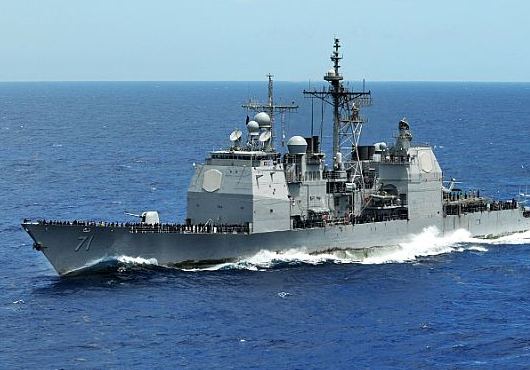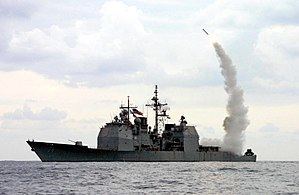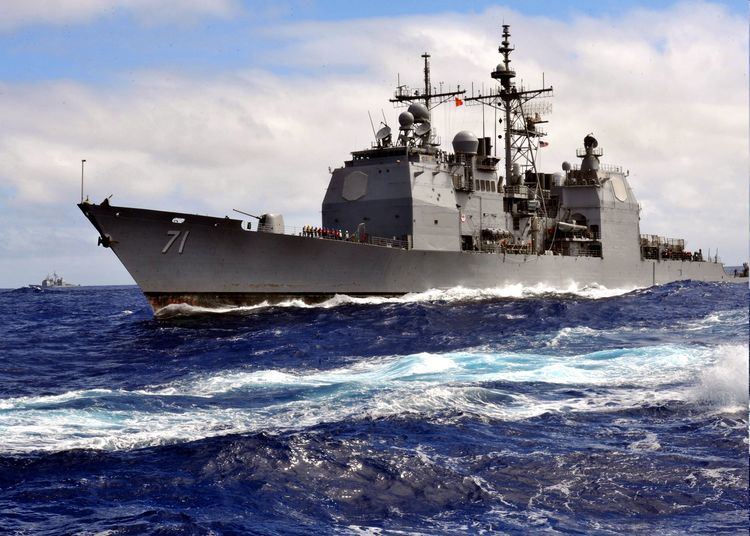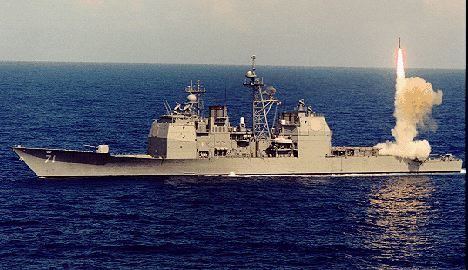Ordered 25 February 1988 Acquired 13 April 1993 Construction started 19 November 1990 Beam 17 m | Laid down 19 November 1990 Commissioned 13 June 1993 Length 173 m Launched 10 January 1992 | |
 | ||
Namesake | ||
USS Cape St. George (CG-71) is a Ticonderoga-class cruiser laid down by the Litton-Ingalls Shipbuilding Corporation at Pascagoula, Mississippi on 19 November 1990, launched on 10 January 1992 and commissioned on 12 June 1993. Cape St. George operates out of San Diego, California, and administratively reports to Commander, Naval Surface Forces Pacific.
Contents
- Uss cape st george cg 71 san francisco bay a ticonderoga class cruiser 10 9 2015
- Etymology
- History
- References

Uss cape st george cg 71 san francisco bay a ticonderoga class cruiser 10 9 2015
Etymology

Cape St. George is named for the World War II Battle of Cape St. George near New Ireland in Papua New Guinea where a U.S. Navy destroyer force led by Captain Arleigh Burke defeated a Japanese destroyer force on 25 November 1943.
History

In March 2003 she was a first responder in support of Operation Iraqi Freedom, awaiting orders from the Mediterranean Sea, off the coast of Turkey. She was part of Cruiser-Destroyer Group 8. The Helicopter Squadron attached to the Cape during this cruise was HSL-44 (out of Mayport Naval Station). During this deployment, the Cape St. George became one of the first US Navy ships to fire cruise missiles from the Mediterranean at a target (Iraq). The Cape soon set sail for the Persian Gulf to continue missile support operations after the Government of Turkey claimed that a cruise missile landed, intact, on Turkish soil. Needless to say, US warships were no longer allowed to fire missiles over Turkish airspace. The Cape St. George then became the first US Navy ship ever to fire from two theaters of battle in history during her five-month cruise, the Mediterranean Sea and the Persian Gulf. The photograph of the USS Cape St. George firing its first missile at Iraq (cover photo) from the Mediterranean Sea was taken by one of two sailors deployed in one of the Cape's two RHIB boats. (Rigid Hull Inflatable Boat) Video footage was also taken and was seen shortly after on CNN. The photograph made papers nationwide soon after and is now the Cape's token photograph.

In May 2005, Cape St. George became the first surface warship certified to use only digital nautical charts (DNC), instead of paper charts using the Voyage Management System (VMS). About 12,000 paper charts have been replaced by 29 computer discs. VMS is part of the Smart Ship Integrated Bridge System, which has been under development since 1990.

On 18 March 2006, she was involved in a firefight with suspected pirates, along with USS Gonzalez. The two US warships exchanged fire with the suspected pirates about 25 nautical miles (46 km; 29 mi) off the coast of Somalia. Initial reports indicated that one suspected pirate was killed and five others wounded while Cape St. George took superficial damage from small arms fire during the action.

In March 2007, Seaman Richard Mott slashed the throat of Seaman Jose Garcia from behind as the 18-year-old ate breakfast on the berthing barge nested aside the ship while she was pierside at BAE Shipyards Norfolk, Virginia for repairs. Garcia was seriously injured but survived. On 7 November 2008, Mott was found guilty of attempted murder and was sentenced to 12 years in prison.
In July 2007, Cape St. George departed Norfolk, Virginia, in transit to her new homeport of San Diego, Californiaas part of the realignment of naval forces following the 2006 Quadrennial Defense Review.
On 17 October 2010, the aircraft carrier USS Abraham Lincoln (CVN-72) and Cape St. George arrived off the coast of Pakistan to support the coalition troop surge in landlocked Afghanistan.
On 31 January 2011, Cape St. George responded to a distress call from a sinking Iranian dhow by dispatching a rescue team via a rigid-hulled inflatable boat (RHIB). The rescue team attempted to repair the dhow's dewatering pumps, but they were unable to stop the flooding. The Iranian fishermen were brought aboard Cape St. George where they were examined by the medical staff before being transferred to an Iranian customs vessel.
6–10 January 2012, accompanying carrier Abraham Lincoln, Cape St. George visited the Gulf of Thailand port of Laem Chabang. During the visit, Singapore-based Glenn Defense Marine Asia (GDMA) provided husbanding services, for which the Navy was billed a total of $884,000. In November 2013, federal prosecutors charged that the Navy had been overbilled more than $500,000.
